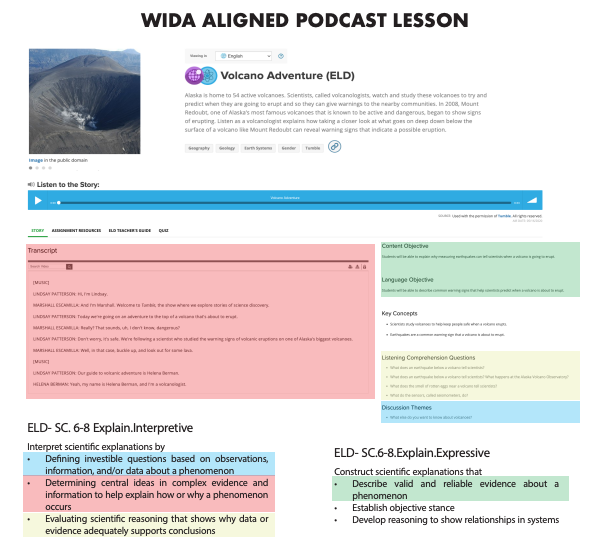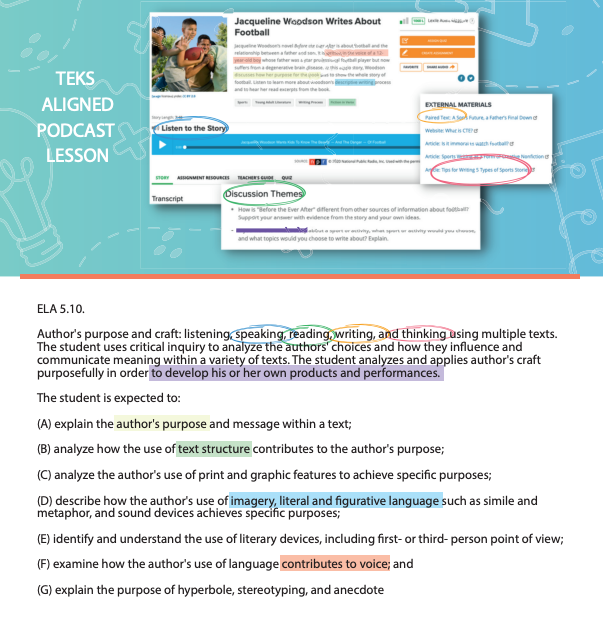
Listening comprehension has long been a part of ELA curriculums and ELL/ESL exams. Still, many teachers might be surprised to find that listening comprehension is getting more attention on state-mandated tests for all students.
The Listening Comprehension Test Landscape
Some listening comprehension tests have been around for years. For example, ACCESS tests delivered by the WIDA Consortium have been around since 2003. Designed for English learners, they include items that assess English listening comprehension for all grades and language levels with an emphasis on assessing and prioritizing academic language development.

ELD teachers have been preparing their students for listening comprehension tests for over two decades. K-12 classroom teachers, however, are just recently becoming more accustomed to the idea of state exams that measure all students’ listening abilities.
Over 20 states now have some form of a listening comprehension test on their ELA exams. With the proliferation of online and computer-based state exams, that number will only continue to grow.
California tests listening comprehension on both the CAASPP (all students) and the ELPAC (EL students only). Many schools we are working with are seeing that listening is a skill that still needs significant instructional focus in the classroom. Just 43% of 8th and 11th graders met listening standards in 2019 across California.
In Texas, listening is woven into the TEKS, although not specifically tested as a separate skill at the moment; we hear that it is under consideration. The introduction for all core ELA courses from Kindergarten to 12th grade include this note about being “read to on a daily basis with opportunities for cross-curricular content and student choice.”

Furthermore, in the TELPAS test the domains of literacy are equally weighted for testing academic language. Students must have a score of advanced high in all four domains in order to be reclassified.
Learn more about how Listenwise is TEKS and ELPS aligned:
The shift we are seeing toward teaching and assessing listening makes sense because it is in line with the research on listening and learning which asserts that better listeners are better learners.
So how can teachers and students prepare for these listening comprehension test portions?
How to Prepare for a Listening Comprehension Test
The absolute best way for teachers to prepare students for a listening comprehension test is to ensure that they have opportunities to listen actively. Practice with quality materials has proven to improve student test scores.
While that sounds simple, teachers who haven’t had to prepare students for these assessments may feel at a loss when faced with deciding how to approach them. So what to do?
Learn the exam format
Most states offer professional development for teachers required to give standardized exams, which should include information about the passage length, genre, how many questions, and what kind. Many times, these training seminars even offer tips to prepare students.
This type of training may not always be available, however. Teachers can then search out information on state testing websites and sites that specialize in delivering test-prep information (like this sample breakdown for California listening tests). Teachers need to be confident when looking at unofficial information that the info is up-to-date. Test information should always be verified through official channels.
Teachers can look for information on test elements like:
- Audio content – Are students listening to articles, stories, conversations, presentations, picture descriptions, etc.,
- Content length – How long are the audio clips?
- Student listening procedure – Are students listening through headphones on a computer or device? Is the teacher reading to the student? Can the audio be repeated? Are there subtitles or transcripts?
- Question formats – Multiple choice, matching, discussion
- Complexity – Do the audio clips get longer/more complex as students progress through the exam?
Most state listening tests are not using a transcript to go along with the audio, and not all tests allow students to listen more than one time, although most tests do allow note-taking on a sheet of paper while students listen.
Once teachers are familiar with the test format, they can design opportunities for students to practice with those formats in the classroom. Providing students with the opportunity to “practice how they play” is a great way to set up students’ confidence and familiarity with listening to just the audio and answering questions afterward.
Using programs like Listenwise, which has interactive transcripts for students to read along as they listen, is a great way to scaffold and practice the skill of listening. Slowly take away the interactive transcript so that students first get comfortable and then are ready to just listen without any support as they will be expected to do on the high stakes test.
Include listening opportunities in the curriculum
Most listening comprehension tests (except those designed for newcomer or emergent English learners) have questions designed much like traditional reading comprehension questions. They are geared toward identifying a central idea or inferring information about a topic.
All that changes is the information gathering mode – students practice listening to gather the information to answer the questions (see #4 below for more about this).
A service like Listenwise is a great way to provide students an opportunity to practice their listening comprehension skills. Listenwise offers multimodal lessons with curriculum supports like transcripts and quizzes and even provides a free pre-assessment to help teachers determine at what levels their students are starting.
However, not all curriculum opportunities need to be digital. Offering brief quizzes based on what the teacher reads or says to the class is a great way to support students’ skills — as long as they know they are practicing and being assessed on their listening skills.
Use rubrics to encourage student responsibility for listening
Making listening part of formal assessments can encourage students to take listening seriously in preparation for a listening comprehension test. For instance, whole-class discussion models are natural assignments with which to assess students’ listening comprehension.
Taking the active view of reading approach and applying it to multimodal lessons makes listening part of the assignment. Now you can add listening expectations into the rubric to assess comprehension. Students may be encouraged to repeat especially salient points or acknowledge another student’s contribution before offering an alternate viewpoint. Formal discussion formats like T-Chart, Pair, Defend, or Stronger Clearer Each Time also demonstrate students listening and responding responsibly to their peers.
For more on how to use podcast lessons to jumpstart class discussions— particularly with English learners— check out our webinar with Dr. Jeff Zwiers:
Empower Students to Support Their Own Listening Comprehension Development
Some students are naturally good listeners. They can listen to a podcast once and relate the critical details while offering their own commentary.
Other students struggle. They need multiple listens and prompting to be able to answer the most straightforward questions.
Teachers that spend time showing students strategies to support their own listening comprehension will see those efforts returned in improved student performance.
Starting students off with graphic organizers is a great place to begin, but they need explanations and examples for organizers to be of use. For example, elementary teachers might give students a t-chart for an audio story that contrasts two sides of a debate (see T-Chart, Pair, Defend). But kids need to learn why using a t-chart makes sense for that story. Is that the best way to organize the information for this particular story?
Giving students organizers at the beginning and progressively teaching them to make their own choices based on what they’re hearing is crucial to encourage strong listening comprehension skills.
Make Listening a Habit
Listening comprehension needs space in the day, much in the way that reading comprehension is spread throughout the curriculum. It might be tempting to have a “listening unit” where students are taught listening strategies and practice them in a confined unit of study, but there are two strong arguments for spreading out listening instruction. Here is how we recommend preparing students for an upcoming listening comprehension test:
- Listening well is a habit that must be built. Habits are not formed in 4-week units. Teachers who know how to prepare students for listening comprehension tests know that regular practice with these skills is key to good performance. Replace some reading assignments with a listening task. Ask colleagues in other subject areas to do the same! If students read a short story in ELA and listen to a related audio podcast in social studies, the skills begin to complement each other naturally.
- Strong listening comprehension skills are echoed in reading comprehension skills. Students who have focused instruction on listening comprehension tend to perform better in other areas of instruction (and state exams), as well. Because the intersection between listening and reading comprehension is so marked, gains in one tend to increase gains in the other.

